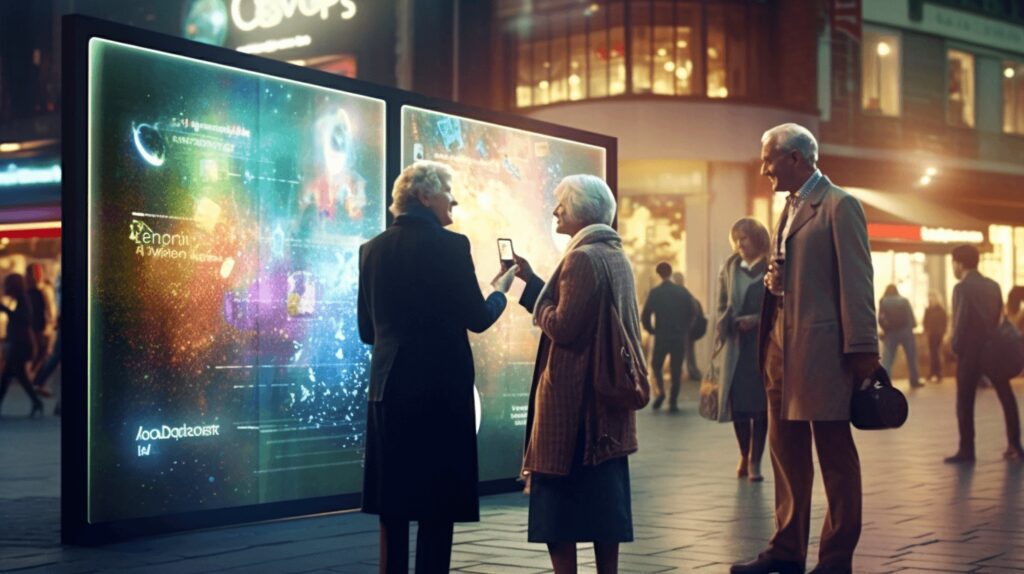In today’s dynamic marketplace, personalization reigns supreme. It’s a universal marketing truth, which applies to all sectors, including the senior living industry. Personalization in marketing, simply put, is the tailoring of a campaign or a strategy to resonate with a specific audience segment’s needs and preferences. It has the transformative power to catapult a business from obscurity to spotlight by fostering deep connections with consumers.
Enter Artificial Intelligence (AI) – the most influential and progressive technology in our current digital age. Imagine blending the power of AI with the magic of personalization, particularly in the realm of senior living marketing. This might be a relatively unexplored territory, but it carries immense potential.
Why? Well, let’s examine a critical aspect. A significant portion of the senior living market consists of older adults and their concerned loved ones. This group has distinctive needs, desires, and anxieties. Traditional, generic marketing strategies can fall flat when addressing such a multifaceted audience. AI-driven personalization, on the other hand, has the ability to create tailored experiences that strike the right chord.
In the following sections, we will dissect how AI-driven personalization can breathe fresh life into senior living marketing, ultimately boosting its effectiveness. Fasten your seatbelts, as we navigate the intriguing world of AI-powered personalization, and see how it can redefine the future of senior living marketing.
The Power of Personalization in Marketing
Engaging your audience in the noisy digital marketplace requires more than a one-size-fits-all approach. Herein lies the power of personalization. It is the not-so-secret ingredient that brands leverage to foster deeper connections with their consumers.
Understanding the Role of Personalization in Marketing
So, what makes personalized marketing an irresistible force in the commercial realm? The answer lies in its ability to enhance customer engagement and drive conversion rates. Picture this – you’re a consumer bombarded with countless promotional messages each day. Now, amidst this chaos, a message tailored specifically for you catches your eye.
It understands your needs, anticipates your interests, and makes a relevant offering. Wouldn’t you feel valued and seen? This is the charm of personalized marketing. It creates meaningful experiences for consumers, which not only captivates their attention but also triggers positive buying behaviors.
By leveraging data analytics and customer insights, businesses can formulate marketing strategies that feel personal to each consumer. This results in a plethora of benefits. Personalized marketing nurtures stronger customer relationships, enhances brand loyalty, and ultimately, leads to increased revenue.
Moreover, it enables businesses to stand out in the highly competitive market, establishing a unique brand image that resonates with the target audience. To put it succinctly, personalized marketing is no longer a ‘nice-to-have’ but a ‘must-have’. Its potential to drive customer engagement and conversions is monumental, making it a game-changing approach for businesses of all sizes and sectors.
The Shift Towards Personalized Marketing
In recent years, we’ve witnessed a significant shift towards personalized marketing. The era of generic, impersonal advertising is gradually fading into oblivion, replaced by customized, consumer-centric campaigns.
Today’s consumers are savvy and discerning. They crave experiences that resonate with them on a personal level and value brands that take the effort to understand and cater to their individual needs. This consumer trend is propelling businesses to adopt personalized marketing strategies, leveraging advanced technologies, such as AI and machine learning, to do so.
Moreover, the rise of digital platforms has facilitated the accumulation and analysis of customer data, further empowering personalized marketing. Social media interactions, website browsing patterns, and online purchase histories provide rich insights into customer preferences, enabling businesses to tailor their offerings with precision.
To sum up, the shift towards personalized marketing signifies a new era of consumer engagement and interaction. It’s an evolution driven by the consumers themselves and facilitated by advanced technologies. As we move forward, this trend is poised to redefine marketing paradigms, delivering enhanced value to both businesses and consumers alike.
The Senior Living Market
The senior living market, a vibrant segment of the healthcare industry, is a complex landscape that is rapidly evolving. This sector provides a variety of living options and services for older adults, focusing on their well-being and independence. In our increasingly aging society, the senior living market is more important than ever.

However, it is not a homogenous group; it comprises a diverse array of individuals with unique needs, preferences, and expectations. Understanding this distinct audience is crucial for creating effective marketing strategies that resonate on a personal level.
Understanding the Senior Living Consumer
Diving into the demographic and psychographic profile of seniors reveals a group with multifaceted needs and preferences. Broadly speaking, senior living consumers fall into two categories: seniors themselves and their concerned family members. Both groups require different approaches in terms of personalized marketing.
Seniors, as consumers, value their independence, quality of life, and the pursuit of interests in their golden years. They tend to prioritize communities that foster social connections, facilitate wellness and leisure activities, and ensure safety and care.
On the other hand, their loved ones often worry about medical care, security, and the overall living conditions in a senior living community. The key is to create a marketing strategy that addresses the concerns of both groups effectively.
The needs and preferences of these consumers are not static; they evolve based on health conditions, lifestyle changes, and even societal trends. Hence, it’s essential for senior living providers to keep a finger on the pulse of their consumers, continuously updating their understanding and adjusting their marketing strategies accordingly.
Personalized marketing, in this context, becomes a necessity, not a choice. It’s the bridge that connects senior living providers with their consumers, enabling a conversation that addresses individual needs and fosters trust.
The Need for Personalized Approaches in Senior Living Marketing
In a market as nuanced as the senior living sector, generic marketing strategies simply won’t cut it. The unique needs of this audience necessitate a personalized approach, one that speaks directly to them, addressing their concerns and desires.
For instance, consider the complexity of the decision-making process involved in choosing a senior living community. It’s an emotionally charged decision, laden with concerns about safety, comfort, health, and well-being.
A generic promotional message that simply highlights the amenities and services of a community is unlikely to alleviate these concerns. Instead, a personalized approach, one that understands and addresses these concerns, can build a deeper connection with potential consumers.
Moreover, the senior living market is saturated with numerous providers, all offering similar amenities and services. To stand out in this competitive landscape, providers need to differentiate themselves, and personalized marketing provides the perfect avenue for this. By showcasing how they can meet the unique needs of individual seniors and their loved ones, providers can position themselves as the preferred choice in the market.
Personalized marketing isn’t just a buzzword in the senior living market. It’s a critical component of effective engagement strategies, driving deeper connections and fostering long-lasting relationships with consumers. It’s the key to unlocking the full potential of senior living marketing.
AI-Driven Personalization Techniques for Senior Living Marketing
Artificial Intelligence (AI) is revolutionizing the way we approach marketing, particularly in the senior living industry. With its ability to analyze large data sets, understand patterns, and make predictions, AI is an invaluable tool for driving personalized marketing. Not only can it tailor content to individual consumers, but it also provides valuable insights into consumer behavior. These insights can inform strategy, improve customer engagement, and boost conversions.

Understanding Consumer Behaviour through AI-Powered Personalization
So, how exactly does AI drive personalization in the senior living sector? The answer lies in its ability to interpret and learn from data. By analyzing the online behavior of seniors and their loved ones – from browsing habits to social media interactions – AI can paint a detailed picture of their preferences, needs, and concerns.
With this information at hand, senior living providers can tailor their marketing messages to speak directly to these individuals, creating a sense of personal connection and understanding.
Let’s take the example of a senior living community that used AI to enhance its marketing. By analyzing its website data, the community identified the most visited pages and content by its prospective residents. This insight was used to personalize their email marketing, with content tailored to each individual’s interests.
The result? Higher email open rates, increased website traffic, and ultimately, more inquiries about their community. This real-life example demonstrates the power of AI-driven personalization in senior living marketing.
Predictive Personalization and Its Role in Future Marketing Strategies
One of the most exciting aspects of AI in marketing is its potential for predictive personalization. This involves using AI to predict future consumer behavior and tailor marketing strategies accordingly. In the context of senior living, predictive personalization could revolutionize the way providers engage with their prospective residents.
For example, AI could analyze a senior’s online behavior and predict their future needs – such as a growing interest in wellness activities or increased concern about healthcare services. Armed with this predictive insight, a senior living provider could proactively tailor their communications and services to meet these needs.
In the near future, we might see predictive personalization playing an even more prominent role in senior living marketing strategies. Imagine a world where marketing messages are not only personalized to your current preferences, but also predict your future needs. This would not only enhance customer engagement, but also foster deeper, long-lasting relationships between senior living providers and their residents.
In conclusion, the future of senior living marketing lies in personalization, powered by AI. As we move forward, we can expect to see AI-driven personalization techniques playing an increasingly integral role in shaping marketing strategies and delivering exceptional customer experiences.
Leveraging AI-Driven Personalization for Effective Senior Living Marketing
In the increasingly competitive senior living industry, providers must find ways to differentiate themselves. One such avenue is through AI-driven personalization, a powerful tool that can elevate marketing strategies, improve customer engagement, and ultimately lead to higher conversion rates. However, the implementation of this technology is a strategic process, requiring understanding, planning, and the right resources.

Practical Steps to Incorporating AI-Powered Personalization into Your Marketing Strategy
Integrating AI-driven personalization into your marketing strategy begins with understanding your audience. Gathering and analyzing data on customer behavior, preferences, and needs is a critical first step. This might involve tracking online interactions, conducting customer surveys, or using CRM software to gather insights.
Once you have a clear understanding of your audience, the next step is to choose the right AI tools. Several platforms can help analyze customer data, provide predictive insights, and automate personalized messaging. Look for tools that are user-friendly, compatible with your existing systems, and provide the level of personalization you need. Remember, the goal is to enhance your marketing efforts, not complicate them.
The final step is to apply these insights to your marketing strategy. This might involve creating personalized email campaigns, tailoring website content, or using targeted advertising. The key is to ensure that your marketing messages resonate with your audience on a personal level, addressing their unique needs and concerns.
Finally, always monitor the effectiveness of your personalized marketing efforts. Are you seeing an increase in engagement, conversions, or customer satisfaction? This will help you refine your approach and make the most of AI-driven personalization.
Case Study: Success Stories in AI-Driven Personalized Senior Living Marketing
Several senior living providers have successfully leveraged AI to personalize their marketing strategies. Let’s take a look at a real-life example. One senior living community decided to leverage AI to analyze the behavior of visitors on their website. This AI system tracked visitor interactions, identified patterns, and provided actionable insights. Using these insights, the community personalized their website content and email communications, tailoring it to the unique interests of each visitor.
The results were impressive. The community saw a significant increase in website engagement, with more visitors spending time exploring their offerings. Additionally, their email open rates increased, and they experienced a higher number of inquiries about their services. This example clearly demonstrates the power and potential of AI-driven personalization in the senior living marketing landscape.
In another instance, a senior living provider used AI to predict the needs of their potential residents. By analyzing online behavior, the AI system could forecast which services or amenities a visitor would likely be interested in. This predictive insight allowed the provider to proactively address these needs, demonstrating their commitment to personalized care and customer satisfaction.
The provider experienced an increase in customer engagement and an uptick in positive customer feedback, validating the effectiveness of AI-driven personalization. These examples underscore the transformative power of AI in senior living marketing. As more providers embrace this technology, we can expect to see even more success stories in the future.
Conclusion
The marketing landscape is shifting towards a more personalized approach, driven by the power of AI. In the senior living sector, this transition opens the door for more meaningful engagements and deeper connections with consumers. It’s an opportunity for marketers to shift from a one-size-fits-all strategy to a more nuanced, personalized one.
AI-driven personalization not only enhances marketing effectiveness but also fosters trust and loyalty among consumers. It allows senior living providers to understand their consumers better, tailor their communications effectively, and meet individual needs proactively.
As we move forward, embracing AI-driven personalization will not be a choice, but a necessity for senior living marketers. It’s a powerful tool that can transform marketing strategies, making them more relevant, engaging, and successful. So, it’s time to embrace AI, harness its power, and unleash the full potential of personalized marketing.
FAQs
How can AI-driven personalization improve senior living marketing strategies?
AI-driven personalization can enhance senior living marketing strategies in several ways. It enables marketers to understand their audience better by analyzing their online behavior and preferences. This, in turn, allows them to tailor their marketing messages to individual consumers, enhancing relevance and engagement. Moreover, AI can predict future consumer behavior, enabling proactive marketing strategies. In the senior living sector, where decision-making is complex and emotional, such personalized marketing can foster deeper connections and trust with consumers.
What are some techniques for effective AI-driven personalization in senior living marketing?
Effective AI-driven personalization in senior living marketing involves several techniques. These include data collection and analysis, segmentation, personalized content creation, and predictive marketing. Tools like AI-powered marketing platforms can facilitate these processes, enabling marketers to implement AI-driven personalization seamlessly.
Can AI-driven personalization help in differentiating a senior living provider in the market?
Yes, AI-driven personalization can be a potent tool for differentiation in the competitive senior living market. By understanding and addressing the unique needs of individual consumers, a senior living provider can position themselves as a more responsive and caring choice. This personalized approach can set a provider apart from the competition, enhancing their market position.
What is the future of AI-driven personalization in senior living marketing?
The future of AI-driven personalization in senior living marketing looks promising. As AI technology continues to evolve and become more sophisticated, its role in personalization will likely grow. We can expect more advanced personalization techniques, more accurate predictive marketing, and even real-time personalization. This evolution will further enhance the effectiveness of senior living marketing, driving better customer engagement and conversions.
Reference
- https://www.mckinsey.com/
- https://mailchimp.com/
- https://emarsys.com/
